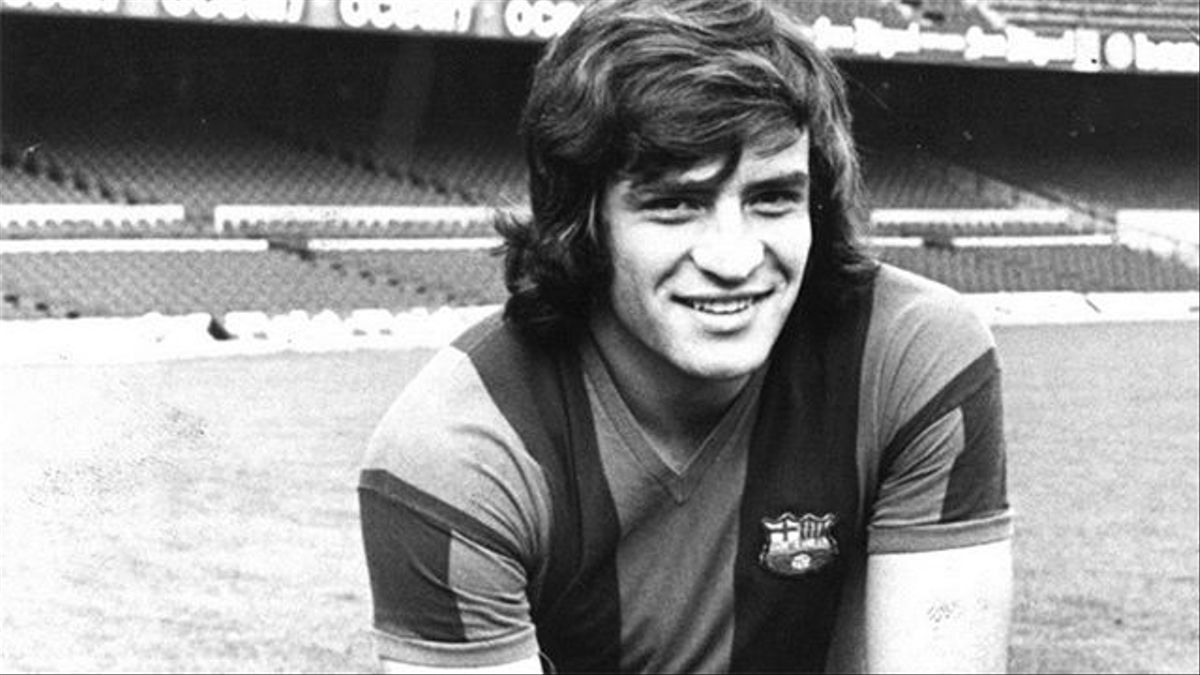In the 1940s there was a Cordoba footballer named Juan Carlos Heredia who came to play for the Argentine National Team.
He was so skillful that with his dribbles he seemed to dance on the ball and milongue to his rivals, that’s why they called him “La Milonga”.
Some decades later, in the ’70s, the third of the four children of “La Milonga”, had the same artistic custom and identical name, Juan Carlos Heredia Jr., inherited the nickname and for the world of football was baptized as ” La Milonguita Heredia ”.
Although the milonga is a River Plate cadence, his dance with the ball was born in Córdoba, the cradle of the quartet, but ended up being consecrated at the Camp Nou, in Barcelona.
“La Milonguita” was an idol in the place where until very recently a certain Lionel Messi was acclaimed and he was a close friend of the great Johan Cruyff, who in addition to being a huge footballer is considered the father and mentor of the exquisite style of football that is taught at La Masía and is enjoyed all over the world.
Barcelona does not forget it and every year invites “La Milonguita” Heredia to return. After each visit the Cordovan returns to his province with his suitcases full of affection, respect and admiration.
A few years ago, Heredia was in Córdoba and in bad shape.
Rony Vargas, representing Cadena 3, took him to Barcelona to relive his years there. Rony told about the idolatry that they still profess for “La Milonguita”: in the best restaurant in Catalonia there is a photo of him with a goal of popcorn.
Rony witnessed the moment when Johan Cruyff, at that time Barsa coach, met “la Milonguita” at the Camp Nou, after many years, and shouted “what are you doing boludo!” With the open arms of wide open.
Juan Carlos Heredia was born in Córdoba on May 1, 1952. “La Milonguita” started at the University, where he made his debut in the old Cordovan League.
image.png
In February 1970, at the age of 17, he joined Belgrano. With “el Cuchi” Cos and “Bocadito” Quiroga they formed a fearsome lead and achieved the league championship that same year, after beating Talleres 1-0 with a goal from “la Milonguita”.
There he was part of a great team in 1971, which shone at the Nacional alongside “Pepona” Reinaldi, “Pato” Laciar, “La Garza” Tocalli and “Tito” Cuellar, among others.
In that season of ’71 he was again champion of the Cordovan League and debuted in the old Nationals in October with a goal, in Belgrano’s victory over Huracán de Comodoro Rivadavia by 5 to 1.
That team scored 5 goals (one from “la Milonguita”) to Chacarita, who had just been champion in the Metropolitan tournament.
In Córdoba, Juan Carlos Heredia played a milonga for Silvio Marzolini, Boca idol and the best 3 in the world.
In 1972 Ángel Labruna took him to Rosario Central, who had just been champion of the ’71 National, there he played for only 4 months and quickly set his eyes on him, none other than Barcelona.
In those years, it was not common for a great European club to be interested in a young Argentine footballer, the League of our country was not televised in Spain, nor were there social networks.
The Heredias lived in a 4×4 room in the Altamira neighborhood and Juan Carlos wanted to lift them out of poverty. When the operation was completed, “Milonguita” removed the clothes that were hanging in her house and handed out 100 dollar bills to surprise her parents.
Due to the number of foreigners, he was unable to join immediately. Barsa loaned him to Porto de Portugal where he was considered the best foreign player of the season.
From there, already with Spanish nationality, he went to Elche in Spain and a season later he arrived at Barcelona.
There he played 119 games, between 1974 and 1980, he won the Copa del Rey in 1978 and the Recopa de Europa in 1979.
Together with Cruyff they made an unforgettable duo, “La Milonguita” playing more at the top and the Dutchman spreading his talent throughout the field.
“La Milonguita” became a star figure. Hundreds of people were waiting for him after training, the press pampered him with their praise, over time the Cordovan won a privileged space in the club’s visited Museum.
In those years “La Milonguita” lived in Castelldefels (very close to Barcelona), in a one-block house, at the foot of the Sierra de Monserrat and 50 meters from the sea.
He had his own zoo, with 18 dogs, four horses, a pygmy goat, a white-faced monkey, and a lion named Simba.
“La Milonguita” usually says that in addition to being well loved, he made a lot of money playing for Barsa, he won millions of dollars.
He remembers that he gave 26 houses and 24 cars to those who “he thought were friends.” He came to Córdoba, bought electrical appliances and gave them away.
His humor and gift of people allowed him to be friends with Johan Cruyff, and he even looked after his dog when he traveled to Holland with his family.
With Cruyff they watched the 78 World Cup final together in a bar in Barcelona.
Shortly before, due to his great performances, DT Ladislao Kubala summoned him to play for the Spanish National Team that was preparing for the ’78 Argentina World Cup.
Something happened that changed history and he decided not to come to the World Cup in Argentina, representing Spain.
His parents lived through a violent and intimidating situation with a group of soldiers who broke into their home in Córdoba.
They asked them where the brochures and weapons were: “My old man, who worked in the Municipality, did not have a damn thing.” In the middle of the operation – they turned the whole house around – a military “capo and soccer player” arrived (that’s how his father described him). He asked why they admired “La Milonguita” so much, the mother said who she was.
“He took out a sheet that had been put on my father’s head and told him: ‘Then you are the Milonga, come on, we were wrong; I apologize.’
After this episode, “la Milonguita” told Kubala that he would not go to the World Cup. Cruyff, in the same bar where they later watched the final, told him: “I am going to show solidarity with you; where there are soldiers, Cruyff does not play. We are going to watch the World Cup together on television.”
image.png
“La Milonguita” is a fan of Belgrano, Barcelona and River.
When he returned to the country, he began to suffer a ligament injury in his left knee that prevented him from performing at his true level and caused his retirement at just 30 years of age.
He was part of the squad of River, champion of the Metropolitan of ’80, but he played very little, he was loaned to Argentinos Juniors and could not even complete a game.
“La Milonguita” was about to retire, but Ángel Labruna offered him to play in a great team at Talleres at Nacional ’82.
The experienced coach asked him to enter the second half of a rough game against the Institute. Heredia, could not move due to the pain in his knee and asked for a change 10 minutes after that complement, Labruna told him to hold on, then Heredia punched “Negro” Enrique Nieto and was expelled.
Right there he decided to end his career. Don Amadeo Nuccetelli, the legendary president of Talleres, asked him to continue, but “La Milonguita” terminated his contract and returned the 0km car that the club had given him.
His father taught him that he never had to steal from anyone, that’s why when he left after returning everything, he looked up at the sky saluting his old man.
By the way, we had already narrated that “la Milonguita” gave houses and cars to her friends. When his dad needed 30 blood givers he made 33 calls. They all agreed to be at the hospital at 7 am, but it was none and ended up paying for the blood.
Juan Carlos Heredia, surely he did not know how to invest, he was too generous and he retired from football when he was very young. Maybe that’s why the fortune he made in football disappeared.
To survive, “Milonguita” worked as a tachero in Córdoba for some years, with a car that he had given to a friend some time ago.
“La Milonguita” Heredia had devotion to her parents. When his father fell ill with cancer, before he passed away, “la Milonguita” sold all the gold medals he had won to buy holy water in Chile to try to cure him. He also had to take care of his mother when she fell ill. Heredia gave up everything and dedicated himself to taking care of her in her last years.
One of the stalls of the Alberdi Giant, the Belgrano stadium, bears his name. Together with his family, his five children and his grandchildren wept with emotion the day he was invited to the baptism of that sector on Arturo Orgaz street.
image.png
“La Milonguita” Heredia has a thousand stories to tell. He was the son of “La Milonga”, who continued milongueando rivals.
He was the powerful and youthful forward who appeared in one of the best versions of Belgrano in all of its history, in 1971.
He was more an idol in Barcelona than Diego Maradona himself and the best antecedent of the idolatry by an Argentine of the Culé fans until the irruption of Lionel Messi.
He was the football partner and close friend of Johan Cruyff.
He was the generous guy, who had everything, but was left with nothing.
To put it better, he thought he had it all, but he kept the most important thing, and sometimes that equates to having it all.
“Milonguita” was left with: the affection of the family, the true friends and the unconditional admiration of the fans, mainly Belgrano and Barsa.
For many years, Juan Carlos Heredia was “La Milonguita” who danced at the Camp Nou.
Source From: Ambito
David William is a talented author who has made a name for himself in the world of writing. He is a professional author who writes on a wide range of topics, from general interest to opinion news. David is currently working as a writer at 24 hours worlds where he brings his unique perspective and in-depth research to his articles, making them both informative and engaging.




